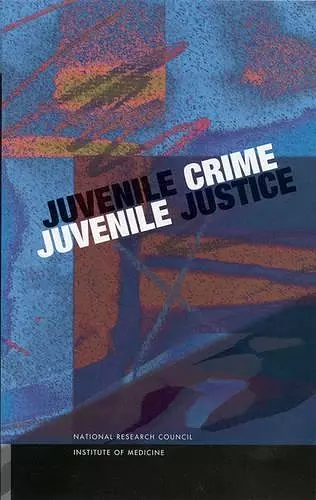Juvenile Crime, Juvenile Justice
National Research Council author Institute of Medicine author Committee on Law and Justice author Board on Children, Youth, and Families author Commission on Behavioral and Social Sciences and Education author Panel on Juvenile Crime: Prevention, Treatment, and Control author Cathy Spatz Widom editor Nancy A Crowell editor
Format:Hardback
Publisher:National Academies Press
Published:5th Jul '01
Currently unavailable, and unfortunately no date known when it will be back

Even though youth crime rates have fallen since the mid-1990s, public fear and political rhetoric over the issue have heightened. The Columbine shootings and other sensational incidents add to the furor. Often overlooked are the underlying problems of child poverty, social disadvantage, and the pitfalls inherent to adolescent decisionmaking that contribute to youth crime. From a policy standpoint, adolescent offenders are caught in the crossfire between nurturance of youth and punishment of criminals, between rehabilitation and "get tough" pronouncements. In the midst of this emotional debate, the National Research Council's Panel on Juvenile Crime steps forward with an authoritative review of the best available data and analysis. Juvenile Crime, Juvenile Justice presents recommendations for addressing the many aspects of America's youth crime problem.
This timely release discusses patterns and trends in crimes by children and adolescents—trends revealed by arrest data, victim reports, and other sources; youth crime within general crime; and race and sex disparities. The book explores desistance—the probability that delinquency or criminal activities decrease with age—and evaluates different approaches to predicting future crime rates.
Why do young people turn to delinquency? Juvenile Crime, Juvenile Justice presents what we know and what we urgently need to find out about contributing factors, ranging from prenatal care, differences in temperament, and family influences to the role of peer relationships, the impact of the school policies toward delinquency, and the broader influences of the neighborhood and community. Equally important, this book examines a range of solutions:
- Prevention and intervention efforts directed to individuals, peer groups, and families, as well as day care-, school- and community-based initiatives.
- Intervention within the juvenile justice system.
- Role of the police.
- Processing and detention of youth offenders.
- Transferring youths to the adult judicial system.
- Residential placement of juveniles.
The book includes background on the American juvenile court system, useful comparisons with the juvenile justice systems of other nations, and other important information for assessing this problem.
Table of Contents- Front Matter
- Executive Summary
- Introduction
- Patterns and Trends in Juvenile Crime and Juvenile Justice
- The Development of Delinquency
- Preventing Juvenile Crime
- The Juvenile Justice System
- Race, Crime, and Juvenile Justice: The Issue of Racial Disparity
- References
- Appendix A: Definition of Offenses Used in Uniform Crime Reporting
- Appendix B: The Indeterminancy of Forecasts of Crime Rates and Juvenile Offenses
- Appendix C: Workshop Agendas
- Appendix D: Biographical Sketches
- Index
ISBN: 9780309068420
Dimensions: unknown
Weight: unknown
404 pages